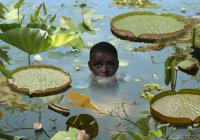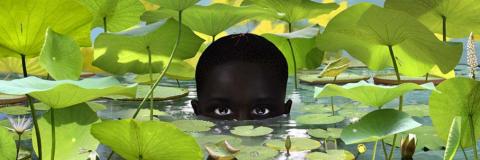The fantastic world of Ruud van Empel
FB: The editing and image manipulation are born with photography. The same day, however, is born also the disagreement that still divides into two camps critics, philosophers and photographers. To make a long history short, on one hand there is who sees photography as a reproduction of reality, and eventually says that any external intervention makes the image non photographic. On the other hand there is who sees photography as personal expression, with those who say that without external interventions photography may not be a work of art.
Personally, I think that photography could embrace both these ideas, and photographers of both schools of thought have produced beautiful images. But is not the same for everyone, expecially for people who belives in the reality of photography.
People believe in the reality of photography but not in that of painting, which gives a huge advantage to photographers. Unfortunately, however, even the photographers believe in the reality of photography.
Duane Michals
Since some years for example, one of the best and well-known Italian photographers, Gianni Berengo Gardin leads a fierce battle against digital retouching and image manipulation. While this is understandable as far as journalism is concerned, I am astonished by certain reactions from the world of artistic photography, which should be much more open.
What do you think about this dichotomous division of photography? Does it happen to hear someone say that your pictures are beautiful but not “real photographies”?
RvE: The opinions are indeed divided about this subject, some people say my work is absolute photography because I photograph and montage everything, so it is in the line of photography.
others say this is contemporary art, and that is also because of its size, I sometimes make very large pieces like World#17 (300 x 100 cm) and because this works different on this large scale it is being experienced more as art than photography.
You could call it photo-art.
FB: The painting references are very important in your images. As well as a clear citation of naif painters like Henri Rousseau, your pictures remind me Renaissance master works, while at the same time remaining very modern. How important is the pictorial tradition in your work? Who are the authors who have particularly inspired you?
To read the rest of this article go to page: 1 2 3 4 5






Massimo Cristaldi
said, December 1, 2007 @ 12:12 PM :
Complimenti per l’Intervista. Bravo l’autore ed interessanti gli scatti.
Ed ancora più interessante, se mi consenti, il tuo tentativo di fare, in lingua italiana quanto JM Colber, ad esempio, fa su Conscentious.
Bravo F!
Fabiano Busdraghi
said, December 1, 2007 @ 3:28 PM :
Ciao Massimo e grazie per la visita.
Il paragone con Conscientious di Colberg è molto lusinghiero. Rispetto a lui però preferisco scrivere meno, ma approfondire di più ogni articolo. Questa è una delle principali linee guida di CameraObscura. Articoli lunghi, completi e approfonditi.
Sto cercando di trovare una soluzione efficace per scrivere in diverse lingue, e pubblicare così anche la versione originale delle interviste, ma per il momento ho dei problemi tecnici che non riesco a sormontare.
Ciao ciao e ancora grazie
merendello
said, December 2, 2007 @ 7:29 PM :
Ciao Fab,
come vedi son finalmente entrato in CameraObscura.
Complimenti per l’intervista: domande intelligenti, impaginazione ottima (odio quando una foto di cui si parla nel testo te la devi andare a cercare).
Apprezzo molto questo tuo modo di far conoscere la fotografia contemporanea.
ciao ciao,
mm
Massimo Cristaldi
said, December 3, 2007 @ 9:28 AM :
Ciao Fabiano,
mi sembra che utilizzi wordpress, giusto? Dai un occhio al plugin “polyglot” che dovrebbe rispondere alla tue esigenze.
Massimo
Fabiano Busdraghi
said, December 3, 2007 @ 10:01 AM :
Grazie massimo del consiglio.
Polyglot è un plugin carino, ma purtroppo, come altri plugins simili tipo Babel, è pensato più per la traduzione di un unico post, e non di un sito intero. Non supporta i tag multilingua, non permette di filtrare il post per ottenere un pdf solo nella lingua corrente, e soprattutto non nasconde i post che non hanno traduzione.
Quest’ultima è la cosa più difficile da ottenere. In pratica, la maggior parte dei plugins multilingua sono efficaci se traduci quasi ogni post in tutte le lingue. Se manca la traduzione di un post stampano qualcosa del tipo “nessuna traduzione per questo post”. CameraObscura sarà principalmente in Italiano e solo occasionalmente in altre lingue. Sarebbe quindi opportuno che il loop wp mostri unicamente i post della lingua corrente.
L’unico plugin che si comporta in questo modo a mio sapere è Gengo. Purtroppo però lo sviluppo è fermo da alcuni mesi, la versione 2.2 è solo parzialmente supportata e non è compatibile con wp 2.3. Visto che questo plugin modifica pesantemente wp ho paura di avere infiniti problemi con gli upgrade successivi di wp. Inoltre solito problema con i pdf e i tag.
Il plugins migliore in assoluto che ho trovato per il momento è Language Switcher. Supporto tag multilingua, filtro dell’output degli altri plugins, documentazione eccellente, aggiornatissimo, etc. Però solito problema che mostra tutti i post.
Un’altra soluzione sarebbe quella di fare un blog indipendente per ogni lingua. Uno quello che è CameraObscura adesso, un’altro per esempio en.cameraobscura.busdraghi.net e via dicendo. È molto facile in questo modo ottenere tutto quello che desidero, l’unico problema è che quando si cambia lingua riesco a trovare si finisce sempre nella homepage dell’altra lingua, non mi viene in mente nessun modo semplice per mostrare se sono disponibili traduzioni del post corrente.
A tuo avviso, è un problema? O sarebbe preferibile avere una lista di post con “nessuna traduzione disponibile” e di tanto in tanto un post tradotto come fa language switcher?
ciao e grazie per il consiglio
f
gianluca
said, December 3, 2007 @ 6:05 PM :
Grazie per esser passato!!
..e continua così!.. un mare di informazioni utilissime
Massimo Cristaldi
said, December 4, 2007 @ 1:52 PM :
Fabiano,
sul mio blog personale ho adottato un approccio molto semplicistico: ho “taggato” con POST in italiano, quei posti che sono *SOLO* in italiano…. Non il massimo ma pratico. Certo, eliminino, su di essi, i lettori inglesi. Altrimenti l’unica alternativa è gestiere due blog in due lingue…. Ma è una fatica immane!
Massimo